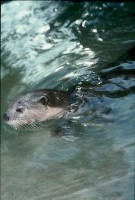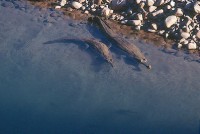|
| |
| National Parks and Sanctuaries : Corbett National Park |
| |
| Abstract |
| |
|
Situated at the foothills of the Himalayas, about 300 km NE of Delhi, Corbett has the distinction of being India's first National Park and also the first Project Tiger Reserve.
With an area of about 1300 sq.km, the topography of the Park encompasses hilly tracts, the Bhabar tract and the alluvial grasslands of the Terai. The altitudinal and rich vegetational variations form the ideal habitat for over 580 species of birds and must definitely figure on the pilgrimage route of any keen birder. While the name Corbett immediately conjures up images of Tigers, this scenically beautiful Park is also a good place to see Asiatic Elephants. The Ramganga draining much of the Park is famous for its Mahseer and also home to the Gharial and Mugger crocodiles, besides a large and visible population of Otter. Chital, Sambar, Muntjac are commonly encountered as are the Langur and Rhesus monkeys.
The best time to visit is between February and May. Wildlife viewing is by jeep and to a limited extent on elephant back.
|
|
|
|
 |
Situated 300 kms. Northeast of New Delhi, Corbett Tiger Reserve is located in the once fabled terai jungles of Uttar Pradesh. It has the distinction of being India’s first National Park.
Forty years after the British first arrived in this area in 1820, these forests, hitherto a flourishing wilderness, had been mercilessly ravaged for their timber. It was a Major Ramsay who made the first systematic effort to stem this devastation. He stopped cultivation in the area, removed cattle stations, established a fire fighting squad and most importantly, stopped the unlicensed felling and removal of timber. The first attempt to have this area declared a game sanctuary was made by two Divisional Forest Officers (DFO) E.R.Stevens and E.A.Symthies in 1916. Although initially unsuccessful, Smythies, now a Conservator, recruited the legendary Jim Corbett as consultant and demarcated the boundaries of the proposed national park, leaving sufficient space for future expansion. However it wasn’t until 1936 that the Hailey National Park named in honour of Sir Malcolm Hailey, the then Governor General of the United Provinces, was gazetted with an area of 325 square kilometres.
|
 |
In 1952 it was renamed the Ramganga National Park after the river which is the lifeline of the Park. In 1957, after the death of Jim Corbett, hunter, naturalist, author, photographer and the man who did more than any other to champion the cause of conservation in these hills, it was renamed Corbett National Park. Project Tiger was launched in 1973 from Corbett National Park, making this the first Tiger Reserve of India.In the late 1980’s the area of the park was increased to more than 1300 sq.km. |
|
|
|
 |
Latitude: 29.25’ - 29.40’ N
Longitude: 78.5’ - 79.5’ E
Corbett Tiger Reserve is situated in the foothills of the Himalayas, straddling the districts of Nainital, Almora, Pauri Garhwal and Bijnore Districts of Uttar Pradesh . This part of the dun terai is called South Patlidun.
Area
The total area of Corbett Tiger Reserve is 1318.54 sq. km. The Tiger Reserve comprises of two management components: The core area consisting of the Corbett National Park measuring 520.82 sq. km. and the buffer zone which comprises of the Sonanadi Wildlife Sanctuary (301.18 sq.km.) and reserve forests (496.54 sq. km.) totaling 797.72 sq. km.
Elevation
Average elevation 400m (1320 ft) above sea level, with the highest point (the Kanda ridge) being 1043m (3441.9 ft) and the lowest 250m (825 ft).
The area of the Park consists of two parallel, east-west running valleys bounded by 3 thickly forested ridges. Between the northern and median ridge is the valley of the Ramganga River, a tributary of the Ganga, which enters the Park from the Northeast and exits at Kalagarh toward the Southwest. A multipurpose hydroelectric dam was built at Kalagarh in 1974-76. The reservoir it created submerged 40 sq. km. of prime grassland in Dhikala. The area to the west of the reservoir now constitutes the Sonanadi Wildlife Sanctuary.
Climate
Temperature range : Maximum temp - 47ºC (116.6ºF)
Minimum temp - 2ºC (35.6ºF)
Rainfall: Average rainfall 1500mm (59 inches) |
|
|
 |
|
|
 |
The Park covers three geographical and topographical regions - the Kumaon hills, Bhabar tracts (just in the foothills of the Himalayas) and the Terai grasslands, which are, wet swampy areas below the Bhabar. The three together form the upper Gangetic plain.
The vegetation here is moist deciduous forest dominated by the Sal (Shorea robusta) and referred to generically as Sal forest. However within this overall vegetation, differences in soil, moisture and aspect create a patchwork mosaic of different vegetation types.
1. The upper slopes carry dry deciduous mixed forests.
2. The middle reaches have moist deciduous forest.
3. The lower hilly ridges and valleys have almost pure stands of ‘Sal’.
4. The ‘Bhabar’ tracts have a rich mix of tall & coarse as well as short and tender grasses.
5. The watercourses are traversed by Shishum (Dalbergia sissoo) which dominates the riverine vegetation.
6. ‘Chaurs’ are the winding strips of alluvial grassland along major watercourses.
|
|
|
|
 |
| Mammals |
One naturally associates the park with Tigers (Panthera tigris)- thanks to Jim Corbett and his unforgettable accounts of the man-eating tigers that he killed in this area. Corbett National Park today, has its fair share of tigers, and one is certainly very likely to come across evidence pointing to this - such as pug marks and scat. Seeing the magnificent animal itself, is as always a matter of chance and good fortune.
The other major predator here is the Leopard (Panthera pardus). The smaller and less visible cats include the jungle cat, leopard cat and the rare fishing cat. Both Sloth Bear (Melursus ursinus) and the Himalayan Black bear (Selenarctos thibetanus) are found here, the latter is rarely seen on the higher hills towards Kanda. |
 |
The Asiatic elephant (Elephas Maximus) is one of the main attractions of Corbett with an estimated population of about 250 -300. The deer found here are Chital (Cervus axis), Sambar (Cervus unicolor) and Muntjac (Muntiacus muntjak). In the higher elevations around Kanda, one may see ghoral (Nemorhaedus goral), a species of mountain-goat. Among the smaller mammals are Yellow throated Marten (Marten flavicula flavicula) , Himalyan palm Civet (Paguma larvata grayi) Indian gray Mongoose (Herpestes edwardsi), Black naped Hare (Lepus nigricollis), Porcupine (Hystrix indica) and Common Otter (Lutra lutra). Schools of otters are seen quite often along various stretches of the Ramganga River. Primates include both the Common Langur (Semnopithecus entellus) and Rhesus Macaque (Macaca mulatta). |
|
| |
| Birds |
All the Himalayas, especially the foothills are a region of immense bio-diversity. There is no more visible manifestation of this than the variety of birds found here and Corbett, encompassing a wide variety of habitats is a perfect example of this. It is a bird watcher's paradise, with over 580 species listed.
Every niche is exploited and there is some avian activity virtually round the clock. One of the most impressive sights here is a busy mixed feeding flock comprising almost a dozen species and including elusive but colourful Laughing Thrushes, Woodpeckers, Drongos, Flycatchers and Magpies foraging noisily through the dense growth. Or waiting on a winters morning for the sun to reach a tangled thicket along a stream bank and the explosion of activity as a bewildering variety of birds come flashing through to feed on the insects stirred by the heat of the sun. Red-billed Leithorix, Niltavas, Mesias, Flycatchers - each a winged jewel. Or sitting under a fruiting ficus and watching in amazement as 2 or 3 species of Green Pigeons and Barbets and Hornbills feed greedily on the fruit. Corbett must definitely figure on the pilgrimage route of any keen birder.
Most of the water birds are migratory and arrive in winter such as the Greylag and Barheaded Geese, Great crested Grebe, Mergansers, Ruddy Shelduck , Black headed Gull, Black Stork to name a few. Corbett is also raptor country with birds such as Osprey, Pallas's fishing Eagle, Grey-headed Fishing Eagle, Crested Serpent Eagle, Rufous-bellied Hawk-eagle, Mountain Hawk-eagle, Harriers, Hawks, Buteos and Owls occurring in large numbers. There is an overlap of high altitude birds here, with such birds as the Lammergeier or bearded vulture, Slatyheaded Parakeet, Chir Pheasant, Forktails seen in the higher reaches of the Park. Five kinds of kingfisher are found here, of which the most impressive is the Himalayan Pied Kingfisher.
|
| |
| Reptiles |
| |
 |
The Ramganga river has two species of crocodiles - the Marsh or Mugger Crocodile (Crocodylus palustris) and the Gharial (Gavialis gangeticus) .The Gharial is an exclusive fish eater and the Ramganga with its good population of Mahseers, Goonch etc, and high sand banks for nesting, is perfect habitat. Other reptiles include, Common Indian monitor, Indian Rock Python, Common and Banded Kraits, Vipers, Common Cobra etc |
|
|
|
 |
Best time to visit
The Park is closed from mid June to mid November due to the monsoon rains. The best time to visit is between February and May.
How to get there
The headquarters of Corbett Tiger Reserve are located in the town of Ramnagar, District Nainital. Ramnagar is easily accessible from Delhi via Moradabad and Kashipur.
Nearest railhead : Ramnagar
Entry formalities
Daytime visitors are permitted to travel only in the Bijrani sector of the National Park. Overnight visitors to Corbett require an entry permit as well as reserved accommodation in one of the Rest houses. The number of entry permits is determined by the number of beds available in the various resthouses maintained by the park. Early booking is therefore recommended.
Where to stay inside the park
Accommodation is available at 24 Rest houses in the Reserve including Bijrani, Gairal, Sultan, Sarpduli, Khinnanauli, Dhikala, Lohachaur and Halduparao. Dhikala is the largest tourist complex and houses a magnificent library. Advance reservations for overnight visitors can be made at the Field Director's office in Ramnagar subject to availability.
Elephant rides through the forest for viewing wildlife are available at Dhikala.
Whom to contact
Field Director, Project Tiger,
Corbett Tiger Reserve,
Ramnagar, Nainital District
Uttar Pradesh 244715
Tel: (05946) 85489
Fax: (05946) 85376
|
|
| |
View Larger Map |
| |
|